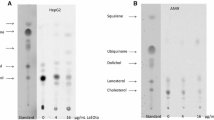Abstract
Animal and human studies designed to examine the effects of α-linolenic acid (ALA) and linoleic acid (LA) supplementation on the fatty acid composition of plasma and tissues have demonstrated a marked difference in incorporation into phospholipids of these 18-carbon precursors of the long-chain polyunsaturates. Whereas tissue phospholipid levels are linearly related to dietary ALA and LA, the levels of tissue LA can be 10-fold higher than tissue ALA even when dietary levels are equivalent. There is some dispute whether this disparity is due to ALA being more rapidly metabolized to its products or substantially oxidized by the liver, or whether LA but not ALA is readily incorporated into cellular phospholipids. We examined the level of incorporation of polyunsaturated fatty acids into human respiratory epithelial cell lines (A549, 16HBE) by determining the dose-dependent incorporation of ALA and LA as free fatty acid (5–150 μg FFA/mL). Cell membrane phospholipid ALA and LA were both increased up to ∼20–30% total fatty acids, with a concomitant decrease predominantly in monounsaturated membrane fatty acids, before significant toxicity was observed (50 μg/mL). Our data support the concept that rather than any inherent inability by human cells to incorporate ALA into membrane phospholipids, the lack of ALA content in human and animal tissues in vivo is due to the rapid metabolism or oxidation of this fatty acid in the liver.
Similar content being viewed by others
Abbreviations
- AA:
-
arachidonic acid
- ALA:
-
α-linolenic acid
- DHA:
-
docosahexaenoic acid
- EPA:
-
eicosapentaenoic acid
- FBS:
-
fetal bovine serum
- FFA:
-
free fatty acid
- LA:
-
linoleic acid
- LCPUFA:
-
long-chain polyunsaturated fatty acid
- PBS:
-
phosphate-buffered saline
- PUFA:
-
polyunsaturated fatty acid
References
Lands, W.E.M. (1995) Long-Term Fat Intake and Biomarkers, Am. J. Clin. Nutr. 61 (Suppl.), 721S-725S.
Mantzioris, E., James, M.J., Gibson, R.A., and Cleland, L.G. (1995) Differences Exist in the Relationships Between Dietary Linoleic and α-Linolenic Acids and Their Respective Long-Chain Metabolites, Am. J. Clin. Nutr. 61, 320–324.
Fu, Z. and Sinclair, A.J. (2000) Novel Pathway of Metabolism of Alpha-Linolenic Acid in the Guinea Pig, Pediatr. Res. 47, 414–417.
Cleland, L.G., Neumann, M.A., Gibson, R.A., Hamazaki, T., Akimoto, K., and James, M.J. (1996) Effect of Dietary n-9 Eicosatrienoic Acid on the Fatty Acid Composition of Plasma Lipid Fractions and Tissue Phospholipids, Lipids 31, 829–837.
Leyton, J., Drury, P.J., and Crawford, M.A. (1987) Differential Oxidation of Saturated and Unsaturated Fatty Acids in vivo in the Rat, Br. J. Nutr. 57, 383–393.
Guarnieri, M., Johnson, R.M., and Du, J.T. (1971) The Unsaturated Fatty Acid Content of Mitochondria in Relation to Oxidation of Exogenous Reduced Nicotinamide Adenine Dinucleotide, Biochim. Biophys. Acta 234, 28–33.
Ward, G., Woods, J., Reyzer, M., and Salem, N., Jr. (1996) Artificial Rearing of Infant Rats on Milk Formula Deficient in n-3 Essential Fatty Acids: A Rapid Method for the Production of Experimental n-3 Deficiency, Lipids 31, 71–77.
Cunnane, S.C., Keeling, P.W., Thompson, R.P., and Crawford, M.A. (1984) Linoleic Acid and Arachidonic Acid Metabolism in Human Peripheral Blood Leucocytes: Comparison with the Rat, Br. J. Nutr. 51, 209–217.
Innis, S.M. (1999) Maternal Diet, Length of Gestation, and Long-Chain Polyunsaturated Fatty Acid Status of Infants at Birth, Am. J. Clin. Nutr. 70, 181–182.
Hwang, D.H., Boudreau, M., and Chanmugam, P. (1987) Efficacy of Linolenic Acid Compared with Longer Chain n-3 Fatty Acids to Inhibit Arachidonic Acid Metabolism in Rats, in Proceedings of the AOCS Short Course on Polyunsaturated Fatty Acids and Eicosanoids (Lands, W.E.M., ed.), pp. 192–214, American Oil Chemists' Society, Champaign.
Broughton, K.S., Johnson, C.S., Pace, B.K., Liebman, M., and Kleppinger, K.M. (1997) Reduced Asthma Symptoms with n-3 Fatty Acid Ingestion Are Related to 5-Series Leukotriene Production, Am. J. Clin. Nutr. 65, 1011–1017.
Broekhuyse, R.M. (1974) Improved Lipid Extraction of Erythrocytes, Clin. Chim. Acta 51, 341–343.
Bligh, E.G., and Dyer, W.J. (1959) A Rapid Method of Total Lipid Extraction and Purification, Can. J. Biochem. Physiol. 37, 911–917.
Makrides, M., Neumann, M.A., and Gibson, R.A. (1996) Effect of Maternal Docosahexanoic Acid (DHA) Supplementation on Breast Milk Composition, Eur. J. Clin. Nutr. 50, 352–357.
Smith, F.B., Kikkawa, Y., Diglio, C.A., and Dalen, R.C. (1982) Increased Saturated Phospholipid in Cultured Cells Grown with Linoleic Acid, In Vitro 18, 331–338.
Goustard-Langelier, B., Alessandri, J.M., Raguenez, G., Durand, G., and Courtois, Y. (2000) Phospholipid Incorporation and Metabolic Conversion of n-3 Polyunsaturated Fatty Acids in the Y79 Retinoblastoma Cell Line, J. Neurosci. Res. 60, 678–685.
Tranchant, T., Besson, P., Hoinard, C., Pinault, M., Alessandri, J.M., Delarue, J., Couet, C., and Gore, J. (1998) Long-Term Supplementation of Culture Medium with Essential Fatty Acids Alters Alpha-Linolenic Acid Uptake in Caco-2 Clone TC7, Can. J. Physiol. Pharmacol. 76, 621–629.
Schonberg, S., and Krokan, H.E. (1995) The Inhibitory Effect of Conjugated Dienoic Derivatives (CLA) of Linoleic Acid on the Growth of Human Tumor Cell Lines Is in Part Due to Increased Lipid Peroxidation, Anticancer Res. 15, 1241–1246.
Usha, S., Maya, A., and Balakrishnan, A. (1996) Mitogenic Stimulation of Primary Cultures of Lung Epithelial Cells by Linoleic Acid, Biochem. Cell. Biol. 74, 289–293.
Author information
Authors and Affiliations
Corresponding author
About this article
Cite this article
Bryan, DL., Hart, P., Forsyth, K. et al. Incorporation of α-linolenic acid and linoleic acid into human respiratory epithelial cell lines. Lipids 36, 713–717 (2001). https://doi.org/10.1007/s11745-001-0776-7
Received:
Revised:
Accepted:
Issue Date:
DOI: https://doi.org/10.1007/s11745-001-0776-7




